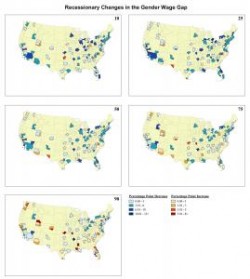“Go West, Young Woman?”: The Geography of the Gender Wage Gap through the Great Recession
Biography
Despite headline-grabbing accounts of the ‘Man-cession’ and childless metropolitan-dwelling
women who earn more than men, the gender wage gap remains persistent. However, the
spatiality of the gender wage gap has received little attention. I ask whether, where, and how the
gender wage gap changed with The Great Recession. Using American Community Survey
pooled surveys for 2005-7 and 2011-13, I model counterfactual wage distributions for full-time
male and female workers in the top 100 metropolitan areas of the U.S., controlling for education,
age, experience, and occupation. Gender inequality is polarizing spatially and across the wage
distribution, and the recession exacerbates this pattern. Gender gaps decline most in the Rustbelt,
but show relative increases in many Western metropolitan areas. Further, declines are mostly
amongst below-median earning workers, whereas increases are likely at the 75th or 90th
percentiles. Disproportionate returns to men’s characteristics explain much of these geographic
and distributional shifts. The combination of geographic and distributional analysis reveals a
more thorough picture of how gender inequality shifted with the recession, as previous patterns
of uneven development under economic restructuring are still evident. The analysis also
signposts regions of emerging gender inequality where relative gender equality is often
presumed, suggesting critical research directions for feminist and economic geographers.




